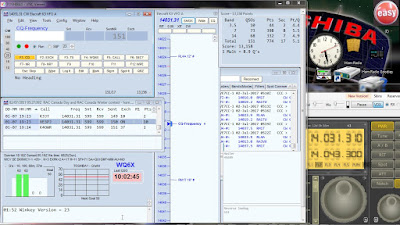Because WQ6X has never participated in the Canadian RAC day I made it a point to fit in some sort of RAC operation for 2017. Being new to the contest, reading the rules became a top/1st priority. [CLICK HERE] to read the rules that I read.
I originally thought of extending the Field Day (FD) setup @ W7AYT to include the RAC GiG
until client obligations obligated me to remain in Alameda.
Lately, remote operating NX6T has stabilized considerably. For the 2017 All Asian contest
I encountered no significant internet problems, leading me to give NX6T-remote a go for the
Canadian RAC contest. Internet-wise I was not disappointed; at least in the beginning.
 |
| C-31 Yagi |
Equipment-wise, I ran NX6T's Station #1 K3 radio barefoot into a C-31 yagi for 20-meters, a 2-el yagi for 40 and a droopy inverted V for 80.
Signal levels were quite good. I worked everyone I could hear. However VE participation in this event left me utterly non-plussed; to say the least.
Typically in contests new to me unexpected things happen out of the nowhere. When I run onsite @ NX6T, any equipment-failure or internet outage can usually be remedied on the spot.
If I'm part of a multi-OP - but connecting remotely - at anytime, I can either phone/text/e-mail a team member to remedy any outage that occurs, usually within minutes. However when I run Single-OP remotely, there is usually no one onsite. If a major outage occurs, all I can do is flip power-strip
power switches and then wait - praying that rebooting everything will eventually stumble into
remedying the outage.
Making this all work requires proper integration between the LogMeIn, RCForb & VPN Viewer software.
As you can see, the RCForb software screen looks remotely similar to the Elecraft K3 front panel; which for
running NX6T remotely is a good thing.
When it was over the RAC contest afforded me the opportunity to learn
a number of new quirks in remote
radio operation.
By the time I configured all the software components on both ends my contest start time was 02:00z (7pm PDT). While I missed out on a possible 15-meter opening, being wide-open, 20 meters seemed to make up for that. What surprised me was the dearth of VE signals and the abundance of stations from the south east. I later discovered that I mis-read the Stepp-IR rotor indicator - it was pointing 115-degrees all along. (For operation on Saturday morning I pointed it Northeast and lo-and-behold Canadian callsigns populated the 20-meter spectrum.)
 |
| WQ6X Spotted on 20-meters |
 |
| WQ6X Spotted on 40-meters |
of the 40-meter skimmers I managed a very productive hour running frequencies. From time to time, either out of dropped-rate or boredom I would make a quick S&P sweep of the band
By 06:40z an 80 meter opening materialized, lasting just under an hour. On both 80 & 40 I was disappointed in the relatively small number of workable (let alone hearable) VE stations. 5 hours
of sleep gave me enough energy to work another hour on 40-meters starting at 12:45z. At 16:25z,
I managed 30 minutes on 20 meters before taking care of some non-contest business.
19:00z brought 25 more QSOs to the log before the internet DIED.
 |
| RAC Contest Ending Statistics |
be able to transmit. As my long-departed friend Mary used to say "It's Always Something!".
Did you work the RAC contest?
How many VE/VY/VA/CF/CG callsigns are in YOUR Log?
P.S.
On Feb 12th (2018) I received the following certificate for this contest.




No comments:
Post a Comment